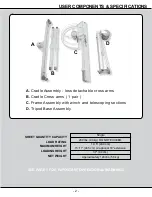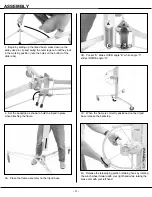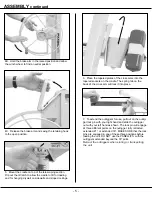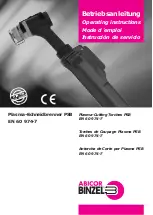
OPERATION
4. The PANELLIFT
®
Drywall Lift will hold drywall in position
on sidewalls and sloped ceilings in addition to level ceilings.
The cradle also tilts up to 10
o
longitudinally.
USE THE BACKSTOP ON THE TRIPOD BASE WHEN
WORKING ON SIDEWALLS AND SLOPED CEILINGS.
When working on sloped ceilings, start at the peak
and work down.
- 6 -
2. To raise the PANELLIFT
®
Drywall Lift rotate the winch
wheel in the direction shown. The brake arm is spring
loaded to hold the winch automatically at any height.
3. To lower the PANELLIFT
®
Drywall Lift control the back-
ward rotation of the winch by grasping the winch handle
with your right hand BEFORE releasing the brake with your
left hand. ALWAYS use this two hand method when lower-
ing the PANELLIFT
®
Drywall Lift.
1. To Load: Set the backstop on the tripod base to hold
the unit in position. Extend the cradle outriggers to properly
support the drywall, tilt the cradle, and swing out the cross
arm support hooks. Load the PANELLIFT
®
Drywall Lift
from the front as shown with the face paper of the drywall
contacting the cradle. (Note: the optional loader attachment
shown on page
12
makes this process even easier.)
When the backstop
legs are set, they
keep the unit from
shifting while loading
wallboard or while
installing the frame
on the tripod base.
DO NOT ROLL
a loaded PANELLIFT
®
Drywall Lift
while the load is raised. Always keep
the load lowered until the lift is in
place beneath the space in which the
loaded wallboard will be installed.
Rolling a PANELLIFT
®
Drywall Lift
while the load is raised can result in
tipping the lift and load possibly
resulting in serious property damage
and/or serious bodily injury.
WARNING
Photos are for ilustrative purposes only.


























